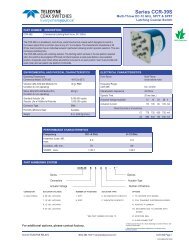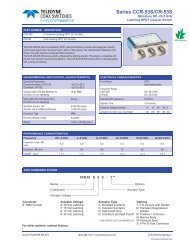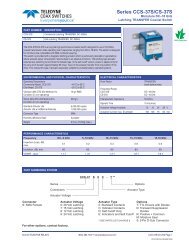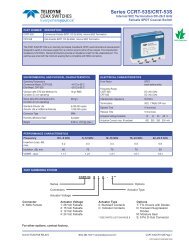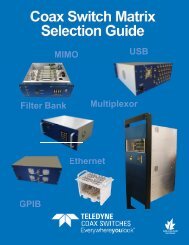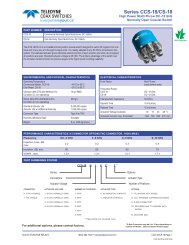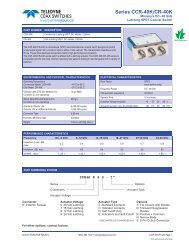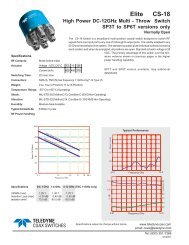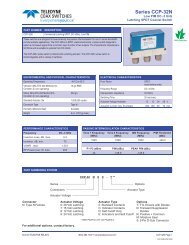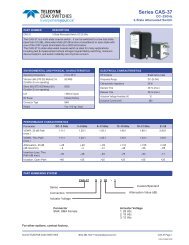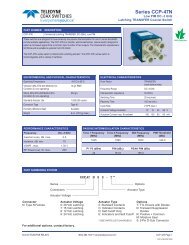Download our Space Databook - Teledyne Relays
Download our Space Databook - Teledyne Relays
Download our Space Databook - Teledyne Relays
Create successful ePaper yourself
Turn your PDF publications into a flip-book with our unique Google optimized e-Paper software.
Product Standards<br />
COAX SWITCHES<br />
The purpose of the TR-HIREL-1 is to provide the user with an established, pre-formatted specification<br />
meeting the requirements of the NASA/GSFC S311-P-754, European <strong>Space</strong> Agency (ESA)<br />
Specification SCC/3601 & 3601 and the latest NASA Document EEE-INST-002, Instructions for EEE<br />
Parts Selection, Screening, Qualification and Derating. The default requirements of the TR-HIREL<br />
meet all three referenced specifications with the following “Final Production Tests” and “Screening and<br />
Electrical Measurements”:<br />
100% Pre-cap inspection - Criteria establishing the standard methods for inspection prior to hermetic<br />
sealing (<strong>Teledyne</strong> <strong>Relays</strong>’ Procedure of Internal Inspection, Document 0-40-115)<br />
Small Particle Inspection/Millipore Clean - in-process inspection to further evaluate relay cleanliness<br />
Through an automated small particle inspection process prior to sealing (<strong>Teledyne</strong> <strong>Relays</strong>’ Pre-cap<br />
Small Particle Inspection, Document 0-40-265)<br />
Sinusoidal Vibration - Standard Vibration test, sinusoidal and random, as specified by MIL-PRF-39016<br />
& MIL-PRF-28776 (MIL-STD-202, Method 204; Test Method: Vibration, High Frequency)<br />
Particle Impact Noise Detection (P.IN.D.) -This test is designed to detect the presence of loose<br />
particles in sealed relays. This test method meets the criteria of MIL-R-39016E, Appendix B*<br />
(<strong>Teledyne</strong> <strong>Relays</strong>’ Particle Impact Noise Detection, Document 0-40-824)<br />
Temperature Conditioning & High and Low Temperature Miss Test - Internal Moisture and High and<br />
Low Temperature Run-In tests per the requirement of MIL-PRF-39016 & MIL-PRF-28776<br />
(MIL-STD-202, Method 107 Test Method: Thermal Shock)<br />
Room Temperature Miss Test - <strong>Relays</strong> shall be subjected to a 2,500 cycle run-in test at<br />
applicable ambient temperatures. (MIL-PRF-39016)<br />
Electrical Measurements - used to prove that the component part can operate safely at its rated<br />
voltage (MIL-PRF-39016 & MIL-STD-202)<br />
© 2013 <strong>Teledyne</strong> Coax Switches (800) 351-7368 • www.teledynerelays.com www.teledynecoax.com • +44 (0) 1236 453124 • www.teledyne-europe.com Page 7



